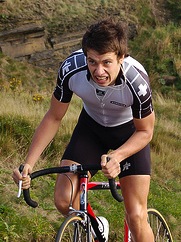 It’s no secret that Philippe Gilbert can shred—especially when road heads downhill.
It’s no secret that Philippe Gilbert can shred—especially when road heads downhill.
In 2009, he and then-teammate Cadel Evans put on a fantastic display of recklessness attempting a late-race escape at the Tour of Romandie. So no surprise here that he hit 74 miles an hour tearing down a training camp descent on the bumper of the team car.
Gilbert’s teammates were similarly unimpressed with the effort, and rattled off their own feats, with one in particular cocking my eyebrows: Adam Blythe’s claim of 73 mph on flat ground behind the team car.
Cyclists have been going very fast behind other vehicles for a long, long time, and with an absolute drafted speed record of 167 mph, the question isn’t really whether Blythe had the ability to do this, but whether he could have pulled it off on a standard road bike.
While chainrings can get pretty much as big as you need, I’m going to assume Blythe did this on a stock setup with a 53×11 top gear. According to the late Sheldon Brown’s gear calculator, that’s 10.1 meters per pedal revolution. 117 kph converts to 1,950 meters per minute; at 10.1 meters per pedal stroke, Blythe would need to turn out a little more than 193 pedalstrokes per minute.
That’s friggin’ fast, but not too far outside what you generally see in a track sprint. Given Blythe’s upbringing on the boards, and the fact that the Internet seems to think 200+ is no problem in a no-resistance sprint effort, I’d say it’s entirely reasonable. And under comparison some other drafted record attempts, it definitely holds up.
Mile-a-Minute Murphey’s famous ride was, according to Les Woodland, accomplished on a 104-inch gear. His 57.8 second mile effort translates to 99.5 kph, or 1,658 meters/minute. Using the .08 conversion from gear inches to meters development, that’s a fraction of a pedal stroke below 200 rpm—in fact higher than Adam Blythe’s cadence.
Conversely, Rompelburg’s record came on a gear offering a staggering 38.4 meters development—meaning he broke 268 kph turning a relatively pedestrian 129 rpm; this correlates well with research indicating the best cadence for power output is around 120rpm.
So to any of Blythe’s Omega Pharma-Lotto teammates who might feel inclined to snatch the youngsters’ record, your best bet is almost certainly to toss on a bigger chainring.
Wish i could build my cadence to above 100rpm on a continuing basis, presently fitness levels seem to limit me to the 90 region for around 10 minutes and that is only when concentrating. All too often i get up to a pace on the trainer and then the mind wanders and the momentum declines.
Anyone with a used 60 on standard 130 bcd please email me as i could be interested skippi@ausi.com. currently i use 55 or 56 .
glad you did the homework i was unwilling to.
raised my brow at this as well…
mahoney
Assuming your gear size theory is correct, 200+ rpm is not the issue; I can pedal in bursts at that rate, and at 43 years old, am well past my prime, which wasn’t all that prime to begin with.
To me the question is sustainability. How long was he at the claimed speed? I can hold 200+ for ca 10 seconds; maybe seasoned pros can hold it longer. But this is a burst, not a steady build up and hold scenario.
I have doubts as to how this was accomplished. Was he at 120 – 150 rpm, and then he and the car both accelerated at the same time, and he held the speed for 10 seconds or so, or is he claiming that he rode along at the speed for beyond 300 meters?
point of clarification on the study cited….the best cadence for maximal, short term power output is quoted at ~120rpm, but lower for sustained efforts. Interestingly Sprint cadences are typically north of that, while Pursuit is typically ~112 rpm IIRC info from the coaching syposium last year.
Do you mind if I quote a couple of your posts as long as I provide credit and sources back to your weblog? My website is in the exact same niche as yours and my visitors would definitely benefit from some of the information you provide here. Please let me know if this okay with you. Regards!